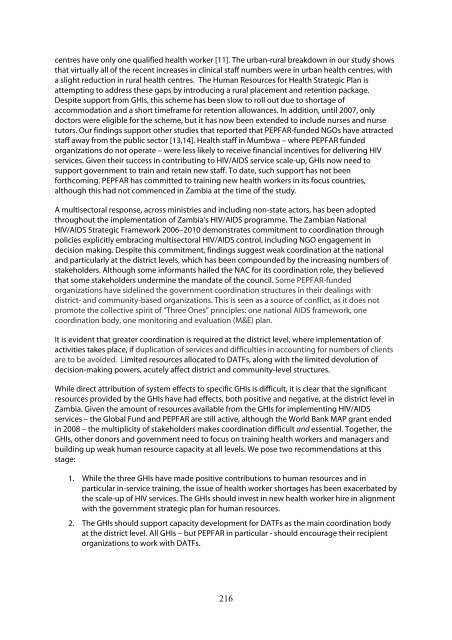MAXIMIZING POSITIVE SYNERGIES - World Health Organization
MAXIMIZING POSITIVE SYNERGIES - World Health Organization
MAXIMIZING POSITIVE SYNERGIES - World Health Organization
Create successful ePaper yourself
Turn your PDF publications into a flip-book with our unique Google optimized e-Paper software.
centres have only one qualified health worker [11]. The urban-rural breakdown in our study shows<br />
that virtually all of the recent increases in clinical staff numbers were in urban health centres, with<br />
a slight reduction in rural health centres. The Human Resources for <strong>Health</strong> Strategic Plan is<br />
attempting to address these gaps by introducing a rural placement and retention package.<br />
Despite support from GHIs, this scheme has been slow to roll out due to shortage of<br />
accommodation and a short timeframe for retention allowances. In addition, until 2007, only<br />
doctors were eligible for the scheme, but it has now been extended to include nurses and nurse<br />
tutors. Our findings support other studies that reported that PEPFAR-funded NGOs have attracted<br />
staff away from the public sector [13,14]. <strong>Health</strong> staff in Mumbwa – where PEPFAR funded<br />
organizations do not operate – were less likely to receive financial incentives for delivering HIV<br />
services. Given their success in contributing to HIV/AIDS service scale-up, GHIs now need to<br />
support government to train and retain new staff. To date, such support has not been<br />
forthcoming. PEPFAR has committed to training new health workers in its focus countries,<br />
although this had not commenced in Zambia at the time of the study.<br />
A multisectoral response, across ministries and including non-state actors, has been adopted<br />
throughout the implementation of Zambia’s HIV/AIDS programme. The Zambian National<br />
HIV/AIDS Strategic Framework 2006–2010 demonstrates commitment to coordination through<br />
policies explicitly embracing multisectoral HIV/AIDS control, including NGO engagement in<br />
decision making. Despite this commitment, findings suggest weak coordination at the national<br />
and particularly at the district levels, which has been compounded by the increasing numbers of<br />
stakeholders. Although some informants hailed the NAC for its coordination role, they believed<br />
that some stakeholders undermine the mandate of the council. Some PEPFAR-funded<br />
organizations have sidelined the government coordination structures in their dealings with<br />
district- and community-based organizations. This is seen as a source of conflict, as it does not<br />
promote the collective spirit of “Three Ones” principles: one national AIDS framework, one<br />
coordination body, one monitoring and evaluation (M&E) plan.<br />
It is evident that greater coordination is required at the district level, where implementation of<br />
activities takes place, if duplication of services and difficulties in accounting for numbers of clients<br />
are to be avoided. Limited resources allocated to DATFs, along with the limited devolution of<br />
decision-making powers, acutely affect district and community-level structures.<br />
While direct attribution of system effects to specific GHIs is difficult, it is clear that the significant<br />
resources provided by the GHIs have had effects, both positive and negative, at the district level in<br />
Zambia. Given the amount of resources available from the GHIs for implementing HIV/AIDS<br />
services – the Global Fund and PEPFAR are still active, although the <strong>World</strong> Bank MAP grant ended<br />
in 2008 – the multiplicity of stakeholders makes coordination difficult and essential. Together, the<br />
GHIs, other donors and government need to focus on training health workers and managers and<br />
building up weak human resource capacity at all levels. We pose two recommendations at this<br />
stage:<br />
1. While the three GHIs have made positive contributions to human resources and in<br />
particular in-service training, the issue of health worker shortages has been exacerbated by<br />
the scale-up of HIV services. The GHIs should invest in new health worker hire in alignment<br />
with the government strategic plan for human resources.<br />
2. The GHIs should support capacity development for DATFs as the main coordination body<br />
at the district level. All GHIs – but PEPFAR in particular - should encourage their recipient<br />
organizations to work with DATFs.<br />
216

















